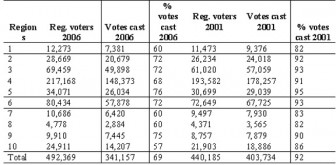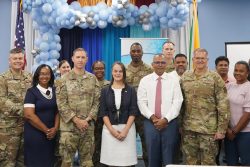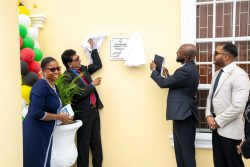A Partnership for National Unity (APNU) has now been formally launched and has given us some idea of its core beliefs: immediate post election national unity government, constitutional change to implement shared governance, a strict separation of powers and equitable distribution of the national wealth. There can be no doubt that these constitute a break with the old divisive politics and are fundamental and necessary prerequisites if Guyana is to provide all of us with the good life. The question then is: what does the alliance now need most to do, at a practical level, to try and dislodge the PPP/C from government?
 In my view, the PPP/C may have alienated some of its core supporters, but our racial context and the mere fact of it being in government and prepared to use its incumbency to the hilt make it a formidable electoral machinery which it will not be easy to totally dislodge. This is particularly so given that the Alliance For Change (AFC) is not and – from the statements of its leaders – will not be part of the arrangement. The electoral data below does however indicate that even with this limited opposition unity, once there is a sensible electoral strategy, success is not totally beyond APNU’s grasp.
In my view, the PPP/C may have alienated some of its core supporters, but our racial context and the mere fact of it being in government and prepared to use its incumbency to the hilt make it a formidable electoral machinery which it will not be easy to totally dislodge. This is particularly so given that the Alliance For Change (AFC) is not and – from the statements of its leaders – will not be part of the arrangement. The electoral data below does however indicate that even with this limited opposition unity, once there is a sensible electoral strategy, success is not totally beyond APNU’s grasp.
Total and % votes registered and cast in 2001/2006
These figures indicate that in 2006, the participation rate was generally low, but more so in traditional opposition regions, with only 57% voting in Region 10, and there is every reason to believe that this low opposition turnout was even more pronounced in traditionally PPP/C regions where, notwithstanding the highly proportional nature of our voting system, they would have had historical reasons to believe that the PPP/C could not be defeated. The confused nature of the PNCR’s campaign in 2006 and the presence of the AFC may also have contributed to the low turnout among traditional PNC voters. However, the total number of opposition votes (TUF excluded) was 150,187 and the total for the PPP/C/TUF 185,071: a difference of 34,884. But 151,212 persons did not vote. Many of these may have left Guyana but the PPP/C has historically been very effective in mobilising its supporters and one feels, therefore, that the votes it received in 2006 represented very close to the possible maximum it could have received.
The recent NACTA poll raised more questions than it answered but even so, it provided some tenuous positive suggestions for the opposition (‘NACTA poll finds PPP in lead:” SN: 17/07/2011). For example, asked which party they will most likely vote for at the next general elections 54% of the respondents did not chose the PPP/C and 57% did not expect any party to win an outright majority. On the other hand, 46% of respondents stated that they will vote for the PPP/C; very close to the 45% Indians in the poll and given the capacity of the PPP/C to mobilize its supporters, 46% could easily become 55% of those who actually cast their votes, for the PPP/C, on the day.
Things are never this simple, but what the data indicate to me is that if APNU is able to get most of the traditional PNC votes and broaden its base somewhat, success is not impossible. However, total mobilisation requires the embedding of a vision that will fire the imagination of the Guyanese people. A vision that will extricate particularly the traditional PNC supporters from their political alienation and younger voters from their fixation with a meaningless and possibly, manipulated, entertainment environment. Of course, all of this is easier said than done and demands that something is said broadly and specifically about the relevance of a vision.
By and large, in the most effective business organisations, it would take about five years to devise and embed a vision and strategy. It is one thing to have a vision and mission statement on paper and quite another thing to embed one. In 1993, President Cheddi Jagan presented his vision of a united Guyana to parliament: nothing was done to make anyone remember it; no one remembers it; the regime is perennially attacked for not having a vision and look where we are today in terms of its general objective. Almost every ministry in the country has some vision or mission statement – indeed some have mission statements without a vision – to which people pay little or no attention, although it might well be one of the most effective ways of incorporating even the most lowly employee into the soul of the organisation. Despite all the time and effort, the attempt to embed the vision of Caricom as a single market economy has not yet succeeded. Of course, in our kind of divided society, it is twice as difficult to develop a national vision, as anything that suits or is proposed by one community is automatically viewed with suspicion by the other!
Therefore, what is required of APNU if it is to make a serious bid to shake off the PPP/C is not simply paper presentations of its intentions but in the little time available to it, an active process of translating words to awareness and excitement and then action at the ballot box. This is not impossible: Barak Obama did it with an holistic effort that was aimed at winning strategic alliance and mass support. The effort to make the American public, indeed most of us, take an Afro-American presidential candidate seriously must have taken much thought. One only needs to peruse Bill Clinton’s biography to appreciate the life-long quest and network development it takes to win a major party nomination and accumulate the additionalities that are required to win the presidency. I have stated before that even when Oprah Winfrey, with her considerable celebrity and media influence, endorsed Obama, I remained most skeptical of his prospects for the democratic nomination, much less the presidency. It was only with the coming on board of the late Senator Edward Kennedy, the eminence grise of the Democratic Party, that I began to think that Obama was in with a chance. In Kennedy, Obama had political celebrity, non African-American ethnicity and, most importantly, the legendary Kennedy network.
In addition to the waning but still existing PNC infrastructure, given its army/ex-army connections, APNU may well have significant logistical/networking capabilities, but these would be of limited utility if not placed within a context in which it is able to stoke the fire of a national imagination excited in the belief that victory and a new and equitable Guyana are possible.









